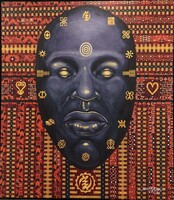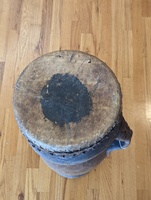MS_0002_FAMU Slavery Memorabilia
Item set
- Title
- MS_0002_FAMU Slavery Memorabilia
- Description
- Resistance to slavery by African people developed almost as soon as the institution itself. Running away remained the number 1 problem for slave holders. Other forms of resistance on the part of Africans included legal petitions, educational pursuits, small- and large-scale rebellions, as well as other forms of protest. Slavery officially ended after the Civil War and the signing of the 13th amendment both occurring in 1865.
- Date Submitted
- May 19, 2008
- Publisher
- Elona M. Jones
- shortDescription
- Iron wrist shackles with a locking end clamp date back to the seventeenth or eighteenth century and bear witness to the cruelty of the black holocaust. These shackles and various weaponry were used in the African slave trade; similar kinds of restraints were manipulated to penalize uncooperative slaves.
- Audience
- General Public, ages 12 and above.
- Alternative Title
- FAMU Slavery Memorabilia Collection
Items
-
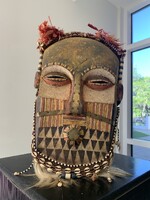 AR_0004_03_Bongo Mask The Kuba kingdom was founded in the 16th century by the Bushoog who are still ruled by a king today. More than twenty tyoes if tribal masks are used among the Kiba or "people of lightning", with meaning and functions that vary from group to group. Ritual ceremonies were an opportunity to display decorative arts and masks to honor the spirit of the deceased or to honor the king. Three types of masks related to Kiba mythological history have been associated with dances that take place in the royal compound, on the occasion of funerals, enthronements, or for circumcisions: the first/ known as Moshambwooy, represents Woot, the founder of the Bushoong sub-tribe, the culture hero.
AR_0004_03_Bongo Mask The Kuba kingdom was founded in the 16th century by the Bushoog who are still ruled by a king today. More than twenty tyoes if tribal masks are used among the Kiba or "people of lightning", with meaning and functions that vary from group to group. Ritual ceremonies were an opportunity to display decorative arts and masks to honor the spirit of the deceased or to honor the king. Three types of masks related to Kiba mythological history have been associated with dances that take place in the royal compound, on the occasion of funerals, enthronements, or for circumcisions: the first/ known as Moshambwooy, represents Woot, the founder of the Bushoong sub-tribe, the culture hero. -
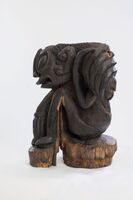 AR_0001_03_0003_Protector of the crops Also known as 'Guardian of the plantain', the calm serene face of the serpent in the 'Protector of the crops' is similar to the face of the lamb being protected by the 'Protector of the flocks of sheep'.
AR_0001_03_0003_Protector of the crops Also known as 'Guardian of the plantain', the calm serene face of the serpent in the 'Protector of the crops' is similar to the face of the lamb being protected by the 'Protector of the flocks of sheep'. -
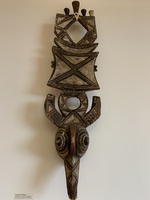 MS_0002_03_031 Gurunsi "Masks" "Gurunsi" includes the Nuna, the Nunuma, the Lela and the Winiama peoples. The masks, characterized by concentric eye circles, geometric shapes and red/black/white color scheme, represent animal spirits.
MS_0002_03_031 Gurunsi "Masks" "Gurunsi" includes the Nuna, the Nunuma, the Lela and the Winiama peoples. The masks, characterized by concentric eye circles, geometric shapes and red/black/white color scheme, represent animal spirits. -
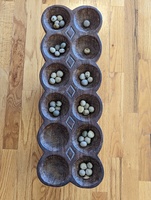 MS_0002_03_028_Oware Oware is reputed to be the oldest game on earth. It is at least 15,000 years old and can be traced back to the Sumerians of ancient Africa. It is one of the oldest sedentary games of Ghana. It is also played in other parts of Africa, but the name varies from country to country.
MS_0002_03_028_Oware Oware is reputed to be the oldest game on earth. It is at least 15,000 years old and can be traced back to the Sumerians of ancient Africa. It is one of the oldest sedentary games of Ghana. It is also played in other parts of Africa, but the name varies from country to country. -
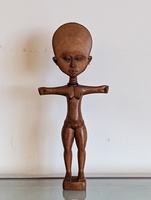 MS_0002_03_027_AfricanArtifactsFlatface Figurines with flat face made from wood. If an Akan woman had difficulty conceiving a child, she would be encouraged to visit a local shrine accompained by a senior women in her family. The woman who was having difficulty with conception would be placed on an altar for a period of time, and later reclaimed along with medicines. The sculpture was then carried, fed, bathed, and otherwise cared for by its commissioner as if it were a living baby. Once the woman had conceived and had a successful delivery, she would return the figurine to the Shrine as a form of offering. If the child died, the woman would keep the Akua'ba as a memorial.
MS_0002_03_027_AfricanArtifactsFlatface Figurines with flat face made from wood. If an Akan woman had difficulty conceiving a child, she would be encouraged to visit a local shrine accompained by a senior women in her family. The woman who was having difficulty with conception would be placed on an altar for a period of time, and later reclaimed along with medicines. The sculpture was then carried, fed, bathed, and otherwise cared for by its commissioner as if it were a living baby. Once the woman had conceived and had a successful delivery, she would return the figurine to the Shrine as a form of offering. If the child died, the woman would keep the Akua'ba as a memorial. -
 MS_0002_03_025 Mwasi Yakumu Iyodade' In this piece, Allen pays homage to Black women as goddesses in an effort to change the image of how God has been portrayed. The beginning of the name, “Mwasi Ya Kumu,” means Queen in the Lingala language of the Democratic Republic of the Congo. “Iyalodé” is also one of the names of the orisha, Oshun.
MS_0002_03_025 Mwasi Yakumu Iyodade' In this piece, Allen pays homage to Black women as goddesses in an effort to change the image of how God has been portrayed. The beginning of the name, “Mwasi Ya Kumu,” means Queen in the Lingala language of the Democratic Republic of the Congo. “Iyalodé” is also one of the names of the orisha, Oshun. -
 MS_0002_03_024 IFE Bronze Heads Ife is and ancient Yorbua city. These naturalist head sculptures, usually depicting royalty, were cast in zinc-bronze or terracotta, and were most popular between the 13th and 15th centuries A.D.
MS_0002_03_024 IFE Bronze Heads Ife is and ancient Yorbua city. These naturalist head sculptures, usually depicting royalty, were cast in zinc-bronze or terracotta, and were most popular between the 13th and 15th centuries A.D. -
 MS_0002_03_023 Rare Wooden Pickaninny Yoke These unique irrigation implements were used on plantations and farms in several Southern states including Florida. The watering device helped double the work productivity of children assigned to this particular labor task.
MS_0002_03_023 Rare Wooden Pickaninny Yoke These unique irrigation implements were used on plantations and farms in several Southern states including Florida. The watering device helped double the work productivity of children assigned to this particular labor task. -
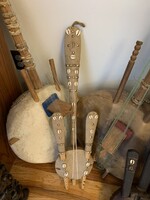 MS_0002_03_0021 Kora A kora is a 21' string harp that originates among the Mandinka people of West Africa. Customarily, the kora is placed by members of djeli families. Djelis are traditional historians, genealogies and storytellers.
MS_0002_03_0021 Kora A kora is a 21' string harp that originates among the Mandinka people of West Africa. Customarily, the kora is placed by members of djeli families. Djelis are traditional historians, genealogies and storytellers. -
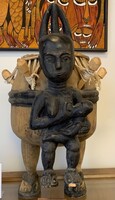 MS_0002_03_0019 Aku'aba/Fertility Dolls In the Akan tradition, these figurines are created to help women overcome difficulties bearing children. There is some variation in the doll across the different Akan ethnic subgroups, but they all function similarly: A woman requests that a doll be made. The doll is taken to a shrine, where rituals are done, prayers are made and medicines given to the hopeful mother. She then wears the doll on her back and cares for it as she would a real baby, until she conceives and delivers. id her real child dies, the mother keeps the aku'aba as a memorial.
MS_0002_03_0019 Aku'aba/Fertility Dolls In the Akan tradition, these figurines are created to help women overcome difficulties bearing children. There is some variation in the doll across the different Akan ethnic subgroups, but they all function similarly: A woman requests that a doll be made. The doll is taken to a shrine, where rituals are done, prayers are made and medicines given to the hopeful mother. She then wears the doll on her back and cares for it as she would a real baby, until she conceives and delivers. id her real child dies, the mother keeps the aku'aba as a memorial. -
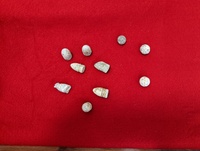 MS_0002_03_0020 Civil War Bullets These rare spent lead bullets are from the Civil War. Both the Union and Confederate armies used such crude ammunition. Half of the black soldiers were either killed, injured or taken as prisoners'. For their acts of courage, the 54th Colored Regiment became legendary and served as examples of black soldiers bravery and patriotism. More than 180,000 black soldiers enlisted with the Union Army, and constituted 10% of its fighting forces. Additionally, black men and women provided service in a variety of non-combat capacities for both the Union and Confederate armies by working as laborers, medical attendants, scouts, spies teamsters, dock workers, etc.
MS_0002_03_0020 Civil War Bullets These rare spent lead bullets are from the Civil War. Both the Union and Confederate armies used such crude ammunition. Half of the black soldiers were either killed, injured or taken as prisoners'. For their acts of courage, the 54th Colored Regiment became legendary and served as examples of black soldiers bravery and patriotism. More than 180,000 black soldiers enlisted with the Union Army, and constituted 10% of its fighting forces. Additionally, black men and women provided service in a variety of non-combat capacities for both the Union and Confederate armies by working as laborers, medical attendants, scouts, spies teamsters, dock workers, etc. -
 AR_0002_03_0018 African Drum a mid-20th century African carved wood drum. An animal skin playing surface above an hour-glass form body and flaring pedestal base, Ear-form handle with mask and feather design. The body carved with incised wave and key designs.
AR_0002_03_0018 African Drum a mid-20th century African carved wood drum. An animal skin playing surface above an hour-glass form body and flaring pedestal base, Ear-form handle with mask and feather design. The body carved with incised wave and key designs. -
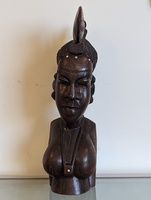 MS_0002_03_0017_The Queen 44- pound ebony carving of a women's head and shoulders from Senegal, West.
MS_0002_03_0017_The Queen 44- pound ebony carving of a women's head and shoulders from Senegal, West. -
 MS_0002_03_0016_Like Father Like Son a 220 pound Shona sculpture carved from an 800 pound block of opal stone by Joseph Mutasa of Harare, Zimbabwe from the Don Hill Collection.
MS_0002_03_0016_Like Father Like Son a 220 pound Shona sculpture carved from an 800 pound block of opal stone by Joseph Mutasa of Harare, Zimbabwe from the Don Hill Collection. -
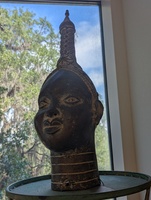 MS_0002_03_0015_Queen of Ife Obtains massive size and different geographical features, Africa, produces a wealth of diverse natural resources including, valuable metals, minerals, stones, animals, fruits and vegetation. In antient times, such resources helped lead to the development of early civilizations or structured societies which were often ruled by opulent (rich) kings and queens. These life-size bronze heads portray 11th and 12th century kings and queens of Ife, Nigeria. Bronze heads like these serves as mounts for the display of royal riches and regalia during annual rites for the king.
MS_0002_03_0015_Queen of Ife Obtains massive size and different geographical features, Africa, produces a wealth of diverse natural resources including, valuable metals, minerals, stones, animals, fruits and vegetation. In antient times, such resources helped lead to the development of early civilizations or structured societies which were often ruled by opulent (rich) kings and queens. These life-size bronze heads portray 11th and 12th century kings and queens of Ife, Nigeria. Bronze heads like these serves as mounts for the display of royal riches and regalia during annual rites for the king. -
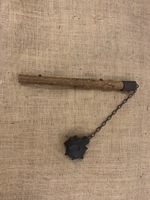 MS_0002_03_0010_Morning Star This specific chain is used to punish enslaved persons who were disobedient to their master. The master would strike the slaves several times until he bled to death or thought that the punishment was enough.
MS_0002_03_0010_Morning Star This specific chain is used to punish enslaved persons who were disobedient to their master. The master would strike the slaves several times until he bled to death or thought that the punishment was enough. -
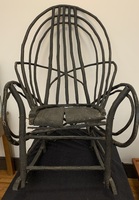 MS_0002_03_0008_HandmadeRockingChair Original Hand Made Rocking Chair created by a former slave.
MS_0002_03_0008_HandmadeRockingChair Original Hand Made Rocking Chair created by a former slave. -
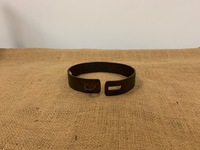 MS_0002_03_0007_Shackles Original Iron Slave Collar used to chain enslaved people of Africa. Dual clasps cuffs affixed by iron chain. Created by a machine.
MS_0002_03_0007_Shackles Original Iron Slave Collar used to chain enslaved people of Africa. Dual clasps cuffs affixed by iron chain. Created by a machine. -
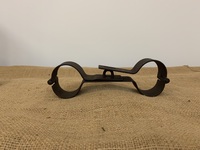 MS_0002_03_0005_HandShackles Original Iron Shackles used to chain enslaved people of Africa. Dual clasps cuffs affixed by iron chain. American Slave Chains. Made of solid iron with grappled or simple-twist locks, these chains were used to restrain the feet or ankles of slaves, allowing them to walk but preventing running or kicking. The leg irons are also known as fetters, shackles, or foot cuffs. Resistance to slavery by African people developed almost as soon as the institution itself. Running away remained the number 1 problem for slave holders. Other forms of resistance on the part of Africans included legal petitions, educational pursuits, small and large scale rebellions, as well as other forms of protest. Slavery officially ended after the Civil War and the signing of the 13th amendment both occurring in 1865.
MS_0002_03_0005_HandShackles Original Iron Shackles used to chain enslaved people of Africa. Dual clasps cuffs affixed by iron chain. American Slave Chains. Made of solid iron with grappled or simple-twist locks, these chains were used to restrain the feet or ankles of slaves, allowing them to walk but preventing running or kicking. The leg irons are also known as fetters, shackles, or foot cuffs. Resistance to slavery by African people developed almost as soon as the institution itself. Running away remained the number 1 problem for slave holders. Other forms of resistance on the part of Africans included legal petitions, educational pursuits, small and large scale rebellions, as well as other forms of protest. Slavery officially ended after the Civil War and the signing of the 13th amendment both occurring in 1865. -
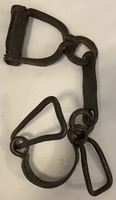 MS_0002_03_0004_Shackles Original Iron Shackles used to chain enslaved people of Africa. Dual clasps cuffs affixed by iron chain. American Slave Chains. Made of solid iron with grappled or simple-twist locks, these chains were used to restrain the feet or ankles of slaves, allowing them to walk but preventing running or kicking. The leg irons are also known as fetters, shackles, or foot cuffs.
MS_0002_03_0004_Shackles Original Iron Shackles used to chain enslaved people of Africa. Dual clasps cuffs affixed by iron chain. American Slave Chains. Made of solid iron with grappled or simple-twist locks, these chains were used to restrain the feet or ankles of slaves, allowing them to walk but preventing running or kicking. The leg irons are also known as fetters, shackles, or foot cuffs. -
 MS_0002_03_0002_Shackles Original Iron Shackles used to enslave people of Africa. Single iron cuff attached by chain to oversized iron ball. This specific item was used to immobilize the slaves. A type of shackle, the ball and chain is designed so that the weight of the iron ball at the end of the short chain restricts and limits the pace.
MS_0002_03_0002_Shackles Original Iron Shackles used to enslave people of Africa. Single iron cuff attached by chain to oversized iron ball. This specific item was used to immobilize the slaves. A type of shackle, the ball and chain is designed so that the weight of the iron ball at the end of the short chain restricts and limits the pace.
